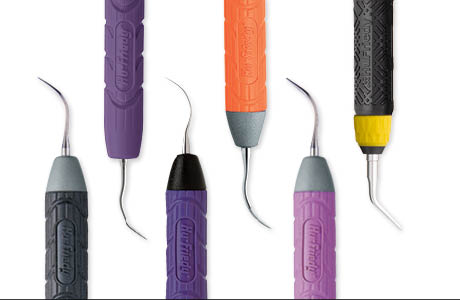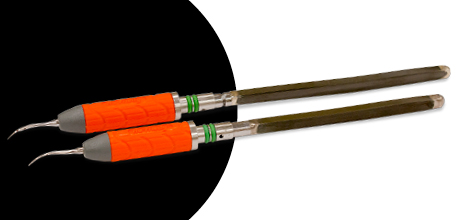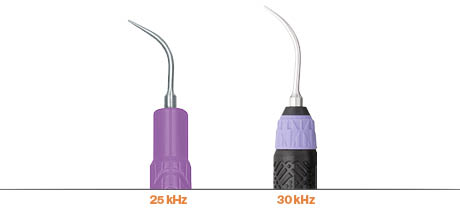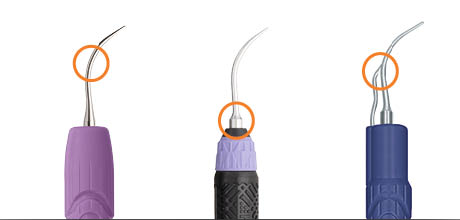

When first created, ultrasonic insert tips were large, bulky and primarily suited for supragingival debridement. Our innovative tip designs have resulted in a variety of shapes and sizes that allow better access and more efficient deposit removal and biofilm disruption. Today, clinicians can choose from a wide range of tip designs from robust to extra thin, and a variety of shank styles all created to allow for better power scaling clinical outcomes.
#10 Universal – this medium-length straight shank extends to a tapered tip, making it a great all-purpose insert for supragingival moderate to heavy removal.
#100 Thin – this long, straight shank extends to a thin tapered tip for generalized light to moderate calculus removal.
#1000 Triple Bend – the unique triple bend shank extends to a tapered, beveled edge tip for increased access around line angles, concentrated energy on corners, and enhanced removal of heavy calculus and stain.
XT – the long, ultra-thin straight shank tapers to a thin tip, which is ideal for narrow, deep pockets, furcations, developmental concavities, and tight areas between misaligned teeth.
XT Triple Bend – the thin, triple bend shank extends to a beveled tip that is 24% thinner than the #1000 Triple Bend, providing increased access around line angles, concentrated energy on corners, and enhanced removal of heavy calculus and stain.
After Five – the probe-sized insert tip has a long shape that narrows to a tapered tip to remove calculus from periodontal pockets with improved adaptation to interproximal areas.
#3 Beavertail – the thick, broad tip is flat for removal heavy deposits, tenacious stain, and orthodontic cement.
Original Prophy – the standard diameter shank extends to a thin, tapered tip for removing light to moderate, moderate to heavy, or orthodontic cement.

You likely perform power scaling on most, if not all, of your patients. A daily schedule of 8 adult patients with 15 minutes of power scaling per patient means having an ultrasonic insert nestled in your hand for at least 2 hours per day. With the amount of power scaling performed, we know you have specific ergonomic and style preferences when it comes to handle type. That’s why we offer variety of distinctive handle options that can provide ergonomic comfort to enhance your clinical efficiency.
Power Plus Inserts - Designed for effective removal of tenacious deposits and heavy extrinsic stain plus extended length to reach deep into periodontal pockets. With a 25% longer tip design, a variety of tip sizes, and a focus on clinician comfort, Power Plus inserts offer an advanced solution for debridement of tenacious deposits.
Streamline™ Plus Inserts - Featuring 360° Swivel handle for additional maneuverability, the lightly textured, wide diameter silicone grip also provides a secure, comfortable grasp. The grip is 18% larger than standard inserts, allowing for reduced finger pinching, less hand fatigue, and increased tactile sensitivity.
Streamline Plus – Featuring the same lightly textured, wide diameter silicone grip as Swivel, without the rotating functionality so you can choose what style is best for you and your equipment. The grip is 18% larger than standard inserts, allowing for reduced finger pinching, less hand fatigue, and increased tactile sensitivity.
Streamline Direct Flow - With a grip that measures in between Swivel & Streamline Plus and Streamline Classic, Streamline Direct Flow offers another comfortable option with through-tip water delivery.
Streamline Classic Inserts - The original lightly textured grip is ideal for those who prefer a slightly smaller diameter handle.

Magnetostrictive generators are typically designed to operate at frequencies of 25 kHz or 30 kHz. This means the generator will cause the insert tip to vibrate either 25,000 times per second or 30,000 times per second. Some generator brands, such as Swerv3™, can accommodate both 25 kHz and 30 kHz inserts with a simple change of the handpiece.
Power setting changes do not change the frequency, or number of vibrations per second. A low power setting while using a 30 kHz insert means the oval will be short in length, a high power setting will produce a longer oval path, but tip movement in both cases will be the identical at 30,000 cycles per second. The same is true of 25 kHz inserts.
Either 25 kHz or 30 kHz inserts will function well to remove debris. However, for optimal scaling performance, it is critical that the kHz or kilohertz of the insert match that provided by the generator.

Water is needed with ultrasonic inserts because of the heat generated during use due to the frictional contact with the tooth surface. Thus, water helps to cool the tip as well as the handpiece so it doesn’t get hot in the operator’s hand.
There are two basic methods to deliver the water to the working end of the insert, or tip – external and internal. The external style of the original insert uses a tube or trumpet running parallel to the tip to deliver water, and the internal design features a hole or channel to guide the water through the hand piece and into the finger grip area where it emerges at the base of the tip or halfway down the working end underneath the curve.
